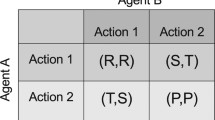Abstract
We investigate how a group of players might cooperate with each other within the setting of a non-cooperative game. We pursue two notions of partial cooperative equilibria that follow a modification of Nash’s best response rationality rather than a core-like approach. Partial cooperative Nash equilibrium treats non-cooperative players and the coalition of cooperators symmetrically, while the notion of partial cooperative leadership equilibrium assumes that the group of cooperators has a first-mover advantage. We prove existence theorems for both types of equilibria. We look at three well-known applications under partial cooperation. In a game of voluntary provision of a public good we show that our two new equilibrium notions of partial cooperation coincide. In a modified Cournot oligopoly, we identify multiple equilibria of each type and show that a non-cooperator may have a higher payoff than a cooperator. In contrast, under partial cooperation in a symmetric Salop City game, a cooperator enjoys a higher return.
Similar content being viewed by others
References
Aumann R., Peleg B. (1960) Von Neumann-Morgenstern solutions to cooperative games without side payments. Bulletin of the American Mathematical Society 66: 173–179
Berge C. (1997) Topological spaces. Dover Publications, Mineola
Border K. (1985) Fixed point theorems with applications to economics and game theory. Cambridge University Press, Cambridge
Chander P., Tulkens H. (1995) A core-theoretical solution for the design of cooperative agreements on transfrontier pollution. International Tax and Public Finance 2(2): 279–294
Chander P., Tulkens H. (1997) The core of an economy with multilateral environmental externalities. International Journal of Game Theory 26: 379–401
Dubey P., Mas-Colell A., Shubik M. (1980) Efficiency properties of strategic market games: An axiomatic approach. Journal of Economic Theory 22: 339–362
Gilboa I. (2009) Theory of decision under uncertainty, econometric society monographs. Cambridge University Press, Cambridge
Kóczy L. (2007) A recursive core for partition function form games. Theory and Decision 63: 41–51
Lafay T. (2010) A linear generalization of Stackelberg’s Model. Theory and Decision 69(2): 317–326
Lau S. -H. P., Mui V. -L. (2008) Using turn taking to mitigate coordination and conflict problems in the repeated battle of the sexes game. Theory and Decision 65(2): 153–183
Mallozzi, L., & Tijs, S. (2007). Coordinating choice in partial cooperative equilibrium, Working Paper, Center for Economic Research, Tilburg University, Tilburg
Mallozzi L., Tijs S. (2008a) Conflict and Cooperation in Symmetric Potential Games. International Game Theory Review 10: 245–256
Mallozzi L., Tijs S. (2008b) Partial Cooperation and Multiple Non-Signatories Decision. AUCO Czech Economic Review 2: 23–30
Monderer D., Shapley L.S. (1996) Potential games. Games and Economic Behavior 14: 124–143
Nash J. (1950) Equilibrium points in n-person games. Proceedings of the National Academy of Sciences 36: 48–49
Nash J. (1951) Non-cooperative games. Annals of Mathematics 54(2): 286–295
Okuguchi K. (1999) Cournot and Stackelberg Duopolies Revisited. Japanese Economic Review 50: 363–367
Ray D., Vohra R. (1997) Equilibrium Binding Agreements. Journal of Economic Theory 73: 30–78
Salant S., Switzer A., Reynolds R. (1983) Losses from horizontal merger: the effects of an exogenous change in industry structure on Cournot Nash equilibrium. Quarterly Journal of Economics 98(2): 185–199
Salop S. (1979) Monopolistic competition with outside goods. Bell Journal of Economics 10(1): 141–156
Simon C.P., Blume L. (1994) Mathematics for economists. WW Norton, New York
Tirole J. (1988) The theory of industrial organization. MIT Press, Cambridge
Zhao J. (1992) The hybrid solutions of an N-Person game. Games and Economic Behavior 4(1): 145–160
Author information
Authors and Affiliations
Corresponding author
Additional information
Previous drafts were circulated under the title “Conflict and Cooperation in Symmetric Games Revisited” and “Partial Cooperation in Symmetric Games”.
Rights and permissions
About this article
Cite this article
Chakrabarti, S., Gilles, R.P. & Lazarova, E.A. Strategic behavior under partial cooperation. Theory Decis 71, 175–193 (2011). https://doi.org/10.1007/s11238-011-9246-7
Published:
Issue Date:
DOI: https://doi.org/10.1007/s11238-011-9246-7



